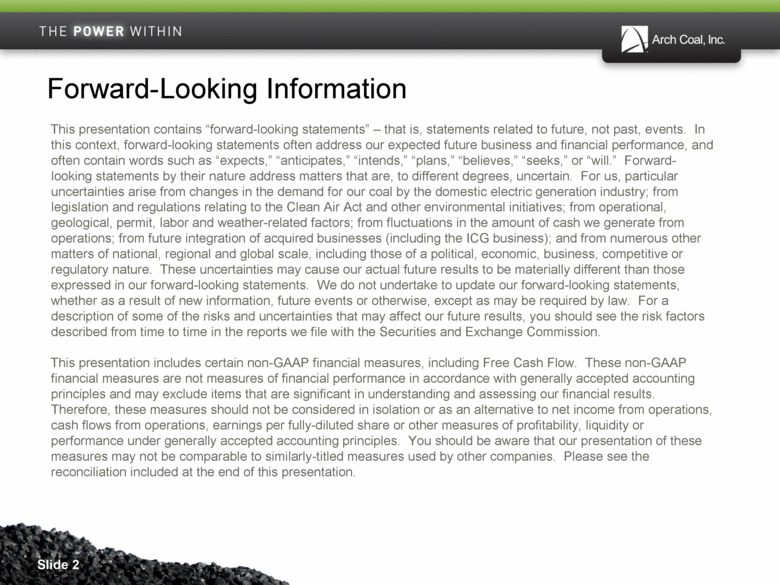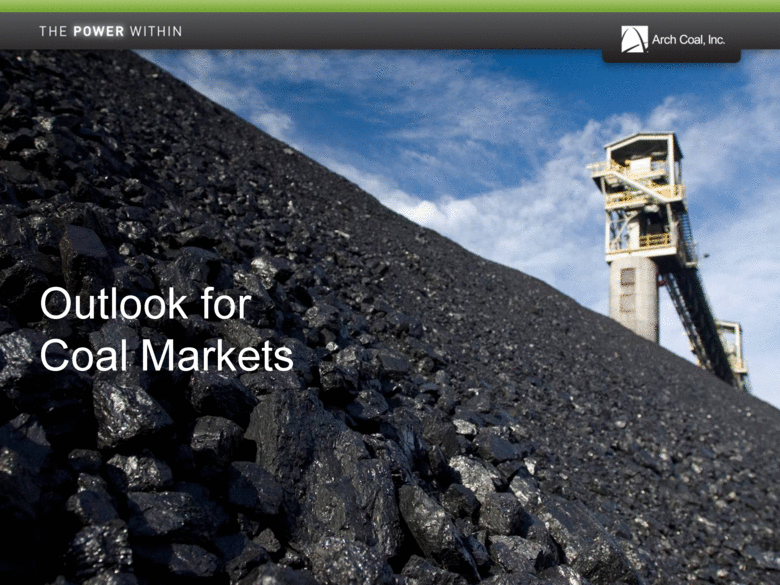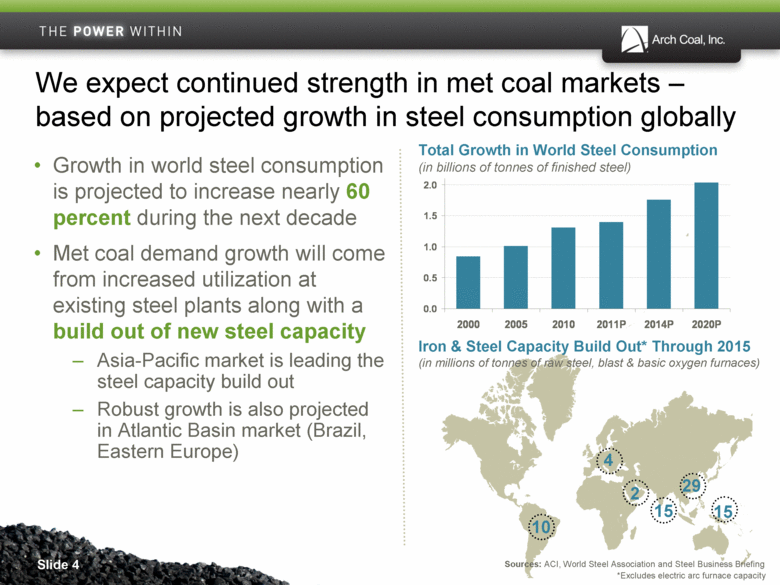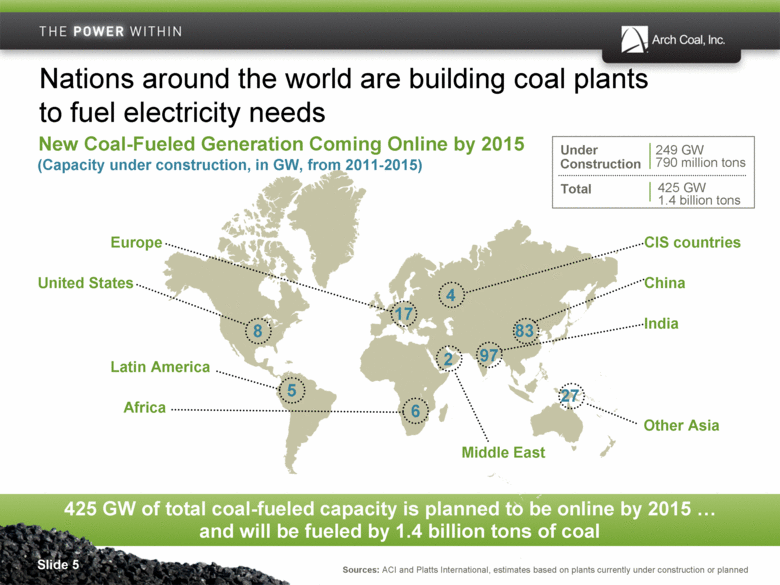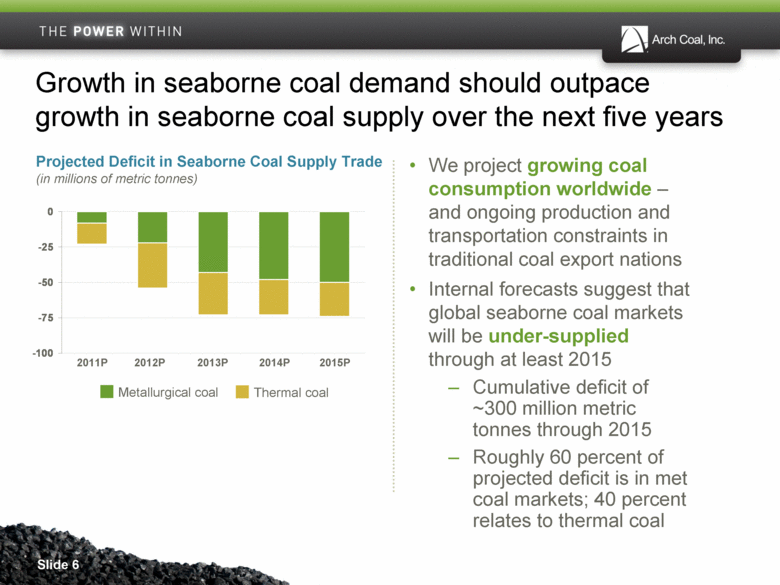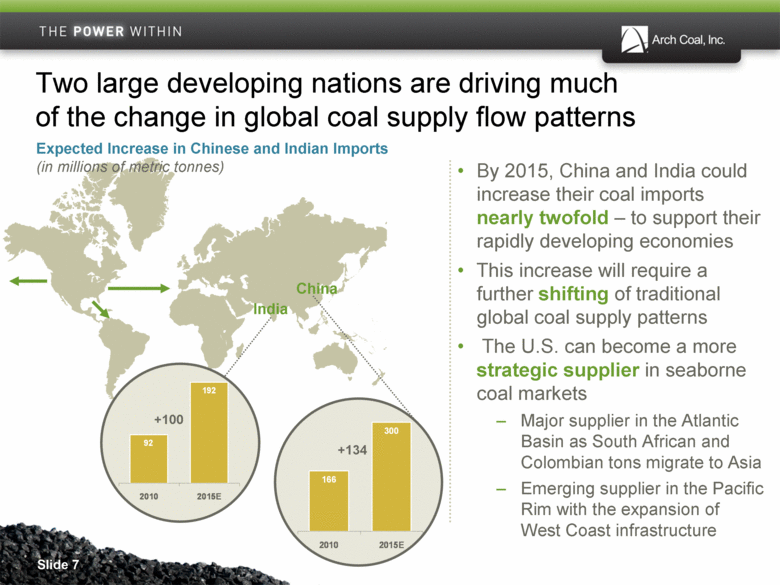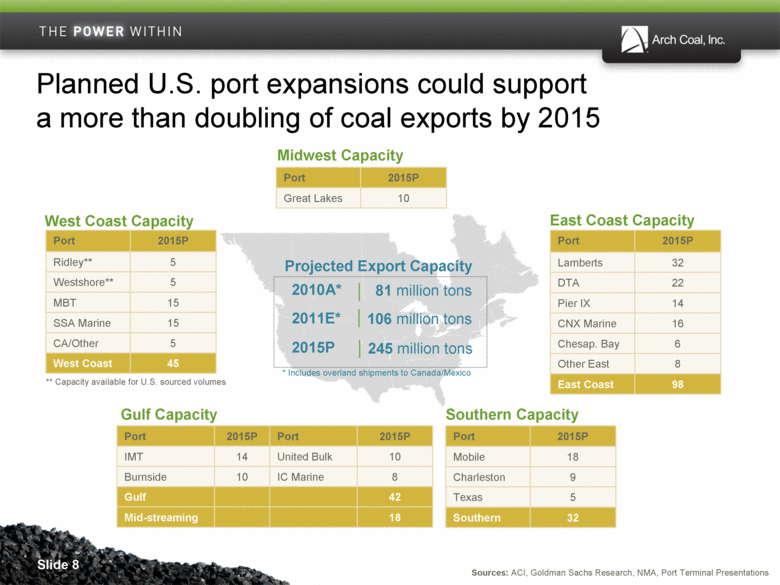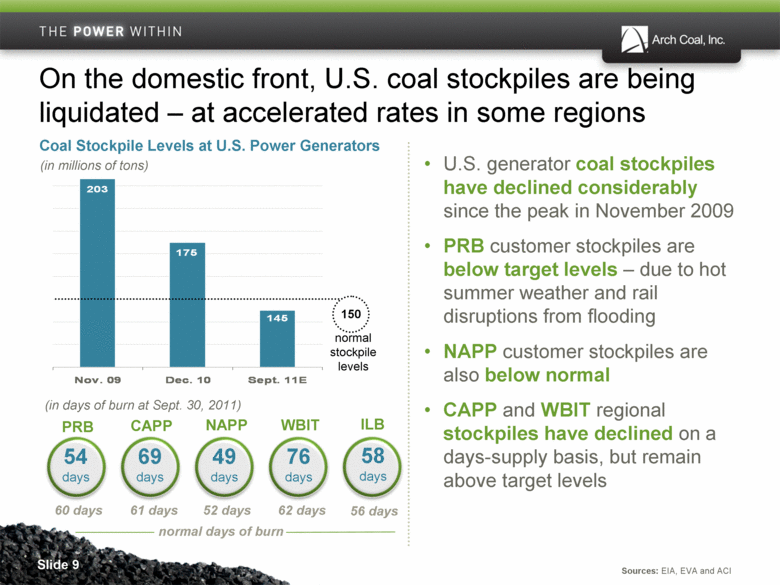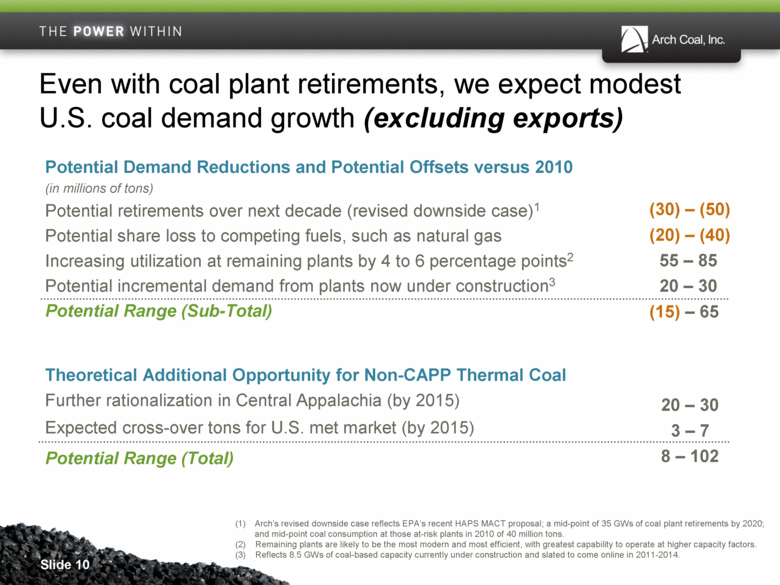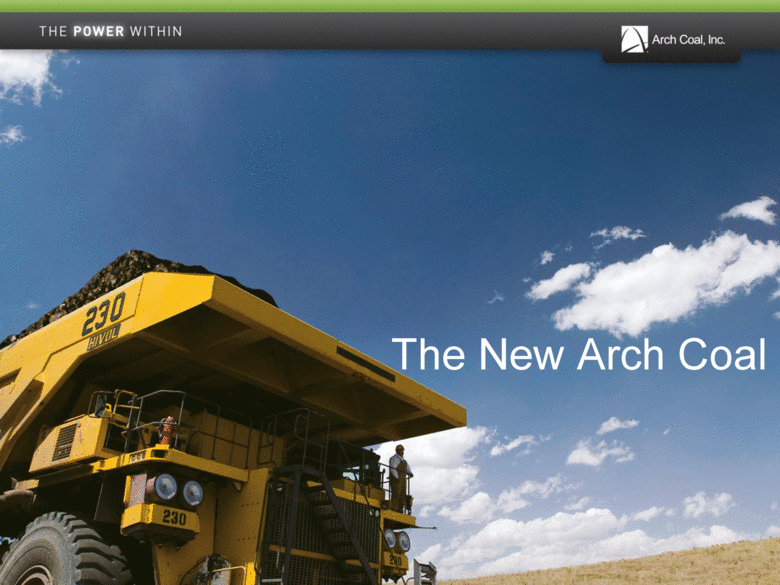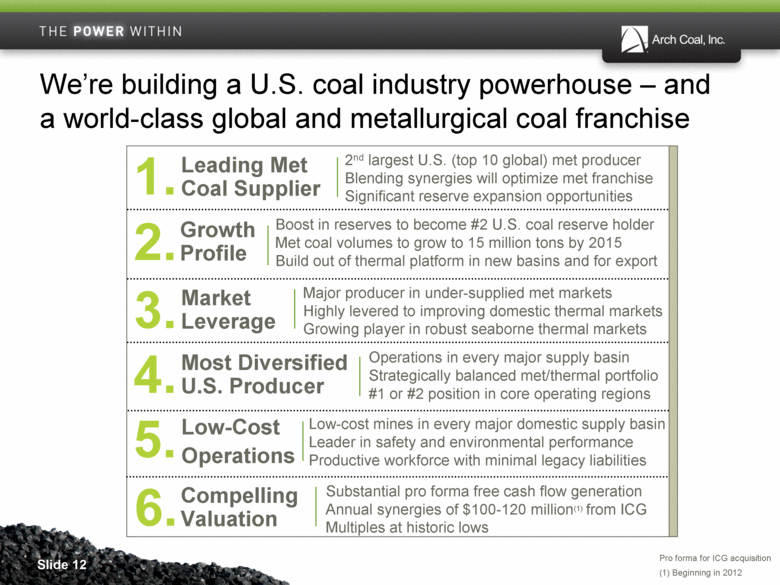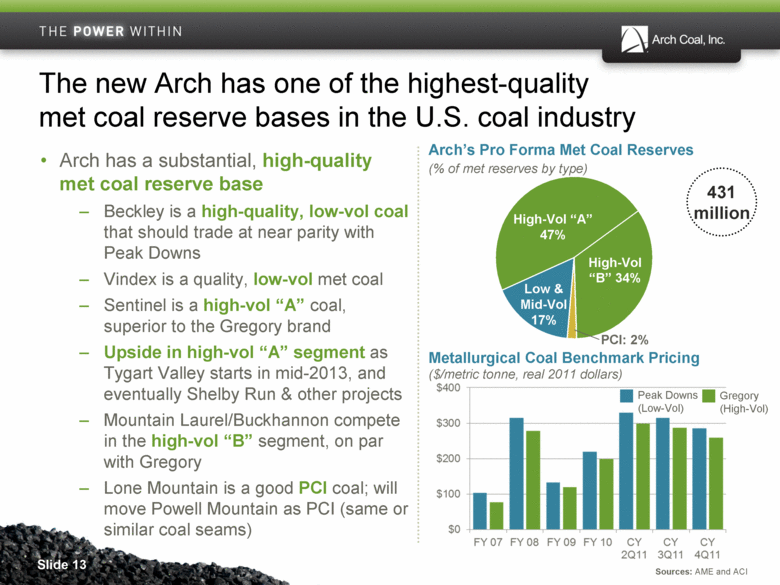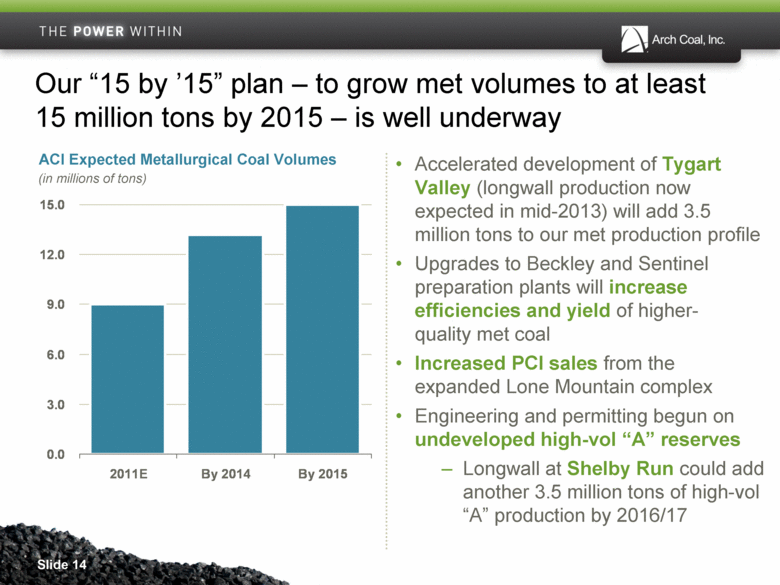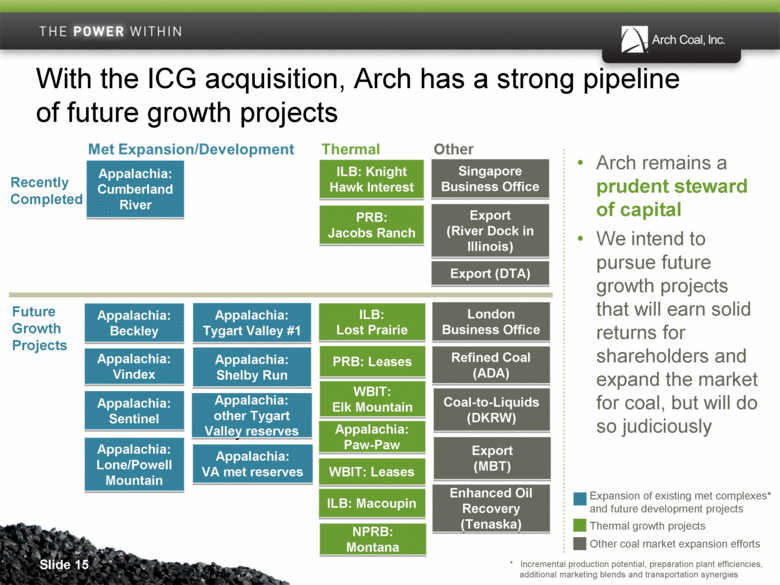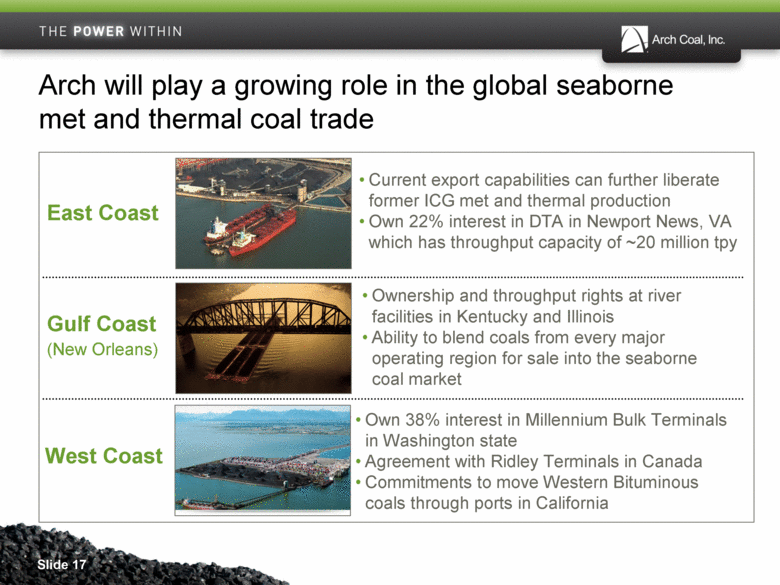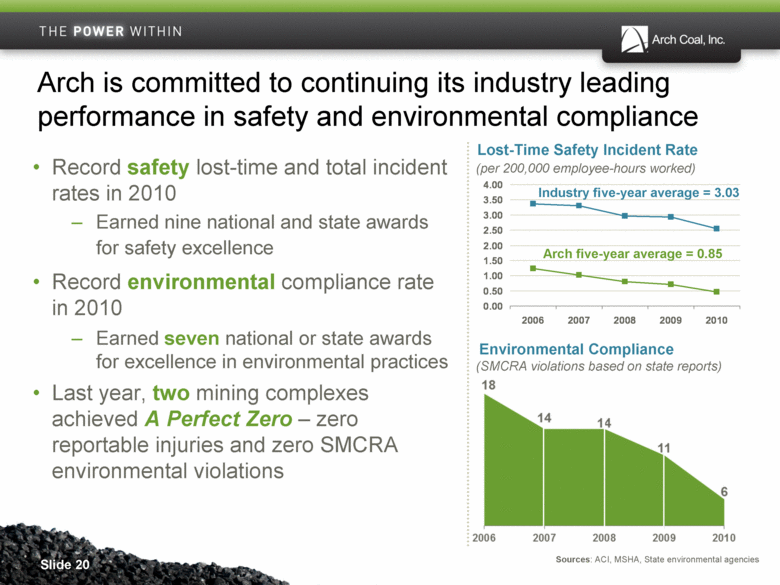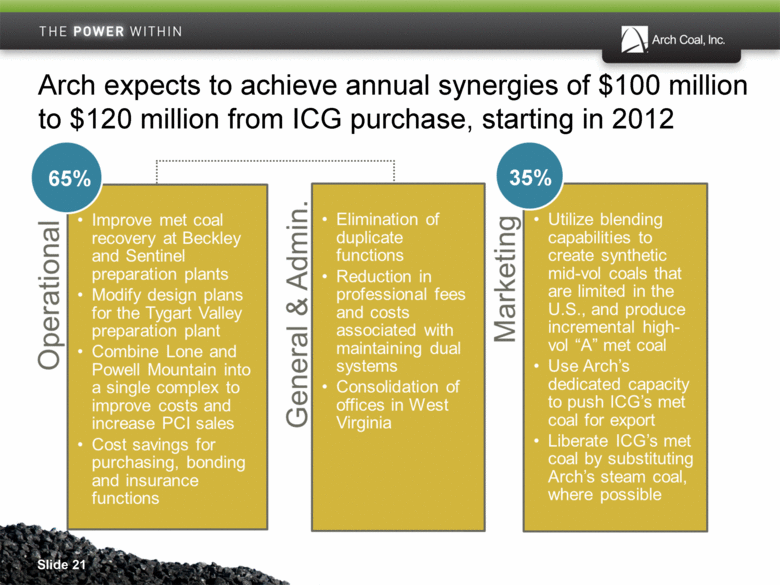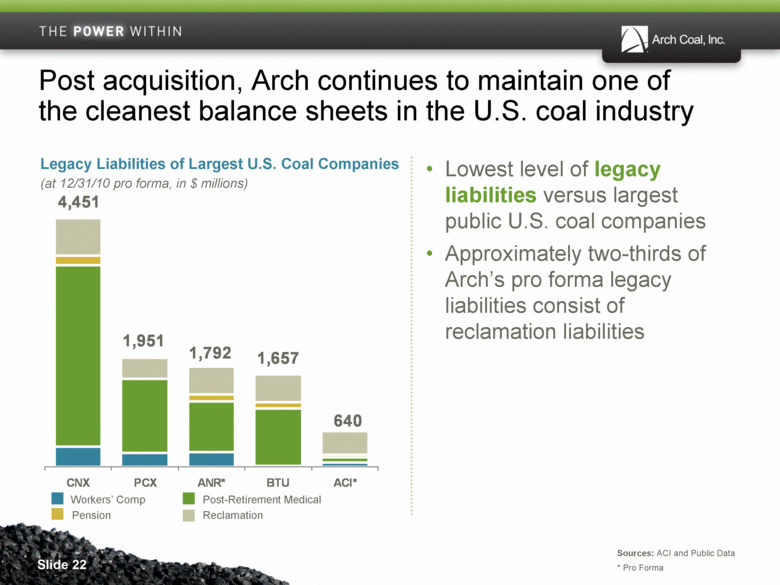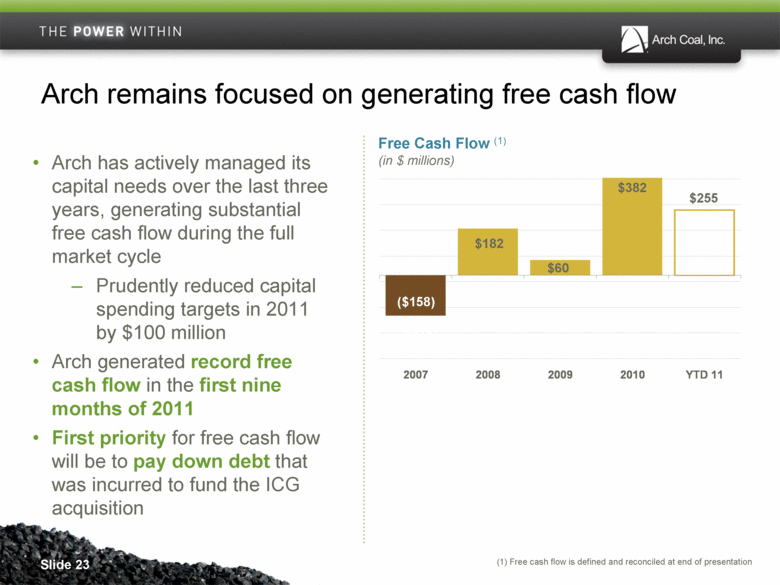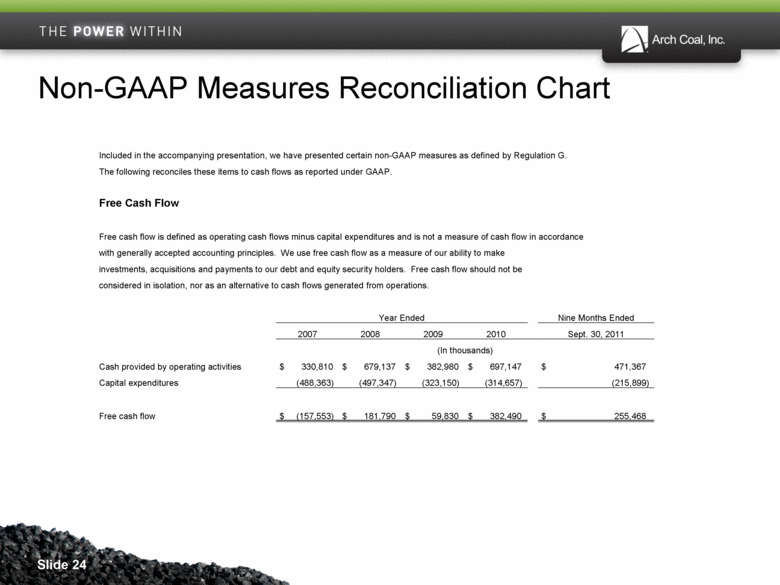Attached files
| file | filename |
|---|---|
| 8-K - 8-K - ARCH RESOURCES, INC. | a11-29495_18k.htm |
Exhibit 99.1
|
|
[LOGO] |
|
|
Slide 2 This presentation contains “forward-looking statements” – that is, statements related to future, not past, events. In this context, forward-looking statements often address our expected future business and financial performance, and often contain words such as “expects,” “anticipates,” “intends,” “plans,” “believes,” “seeks,” or “will.” Forward-looking statements by their nature address matters that are, to different degrees, uncertain. For us, particular uncertainties arise from changes in the demand for our coal by the domestic electric generation industry; from legislation and regulations relating to the Clean Air Act and other environmental initiatives; from operational, geological, permit, labor and weather-related factors; from fluctuations in the amount of cash we generate from operations; from future integration of acquired businesses (including the ICG business); and from numerous other matters of national, regional and global scale, including those of a political, economic, business, competitive or regulatory nature. These uncertainties may cause our actual future results to be materially different than those expressed in our forward-looking statements. We do not undertake to update our forward-looking statements, whether as a result of new information, future events or otherwise, except as may be required by law. For a description of some of the risks and uncertainties that may affect our future results, you should see the risk factors described from time to time in the reports we file with the Securities and Exchange Commission. This presentation includes certain non-GAAP financial measures, including Free Cash Flow. These non-GAAP financial measures are not measures of financial performance in accordance with generally accepted accounting principles and may exclude items that are significant in understanding and assessing our financial results. Therefore, these measures should not be considered in isolation or as an alternative to net income from operations, cash flows from operations, earnings per fully-diluted share or other measures of profitability, liquidity or performance under generally accepted accounting principles. You should be aware that our presentation of these measures may not be comparable to similarly-titled measures used by other companies. Please see the reconciliation included at the end of this presentation. Forward-Looking Information |
|
|
Outlook for Coal Markets |
|
|
We expect continued strength in met coal markets – based on projected growth in steel consumption globally Slide 4 10 4 2 15 29 15 Total Growth in World Steel Consumption (in billions of tonnes of finished steel) Iron & Steel Capacity Build Out* Through 2015 (in millions of tonnes of raw steel, blast & basic oxygen furnaces) Sources: ACI, World Steel Association and Steel Business Briefing *Excludes electric arc furnace capacity Growth in world steel consumption is projected to increase nearly 60 percent during the next decade Met coal demand growth will come from increased utilization at existing steel plants along with a build out of new steel capacity Asia-Pacific market is leading the steel capacity build out Robust growth is also projected in Atlantic Basin market (Brazil, Eastern Europe) 0.0 0.5 1.0 1.5 2.0 2000 2005 2010 2011P 2014P 2020P |
|
|
425 GW 1.4 billion tons Africa Europe Nations around the world are building coal plants to fuel electricity needs 425 GW of total coal-fueled capacity is planned to be online by 2015 and will be fueled by 1.4 billion tons of coal New Coal-Fueled Generation Coming Online by 2015 United States Middle East Latin America CIS countries China Other Asia India 17 6 2 8 5 97 27 83 4 (Capacity under construction, in GW, from 2011-2015) Sources: ACI and Platts International, estimates based on plants currently under construction or planned Under Construction 249 GW 790 million tons Total Slide 5 |
|
|
Growth in seaborne coal demand should outpace growth in seaborne coal supply over the next five years Projected Deficit in Seaborne Coal Supply Trade (in millions of metric tonnes) 2011P 2012P 2013P 2014P 2015P Slide 6 We project growing coal consumption worldwide – and ongoing production and transportation constraints in traditional coal export nations Internal forecasts suggest that global seaborne coal markets will be under-supplied through at least 2015 Cumulative deficit of ~300 million metric tonnes through 2015 Roughly 60 percent of projected deficit is in met coal markets; 40 percent relates to thermal coal Metallurgical coal Thermal coal -100 -75 -50 -25 0 |
|
|
Two large developing nations are driving much of the change in global coal supply flow patterns +100 +134 Expected Increase in Chinese and Indian Imports (in millions of metric tonnes) By 2015, China and India could increase their coal imports nearly twofold – to support their rapidly developing economies This increase will require a further shifting of traditional global coal supply patterns The U.S. can become a more strategic supplier in seaborne coal markets Major supplier in the Atlantic Basin as South African and Colombian tons migrate to Asia Emerging supplier in the Pacific Rim with the expansion of West Coast infrastructure China India Slide 7 192 92 2010 2015E 166 300 2010 2015E |
|
|
Planned U.S. port expansions could support a more than doubling of coal exports by 2015 East Coast Capacity Port 2015P Lamberts 32 DTA 22 Pier IX 14 CNX Marine 16 Chesap. Bay 6 Other East 8 East Coast 98 West Coast Capacity Port 2015P Ridley** 5 Westshore** 5 MBT 15 SSA Marine 15 CA/Other 5 West Coast 45 Gulf Capacity Port 2015P Port 2015P IMT 14 United Bulk 10 Burnside 10 IC Marine 8 Gulf 42 Mid-streaming 18 Midwest Capacity Port 2015P Great Lakes 10 Southern Capacity Port 2015P Mobile 18 Charleston 9 Texas 5 Southern 32 2011E* 2015P 106 million tons 245 million tons Sources: ACI, Goldman Sachs Research, NMA, Port Terminal Presentations * Includes overland shipments to Canada/Mexico 2010A* 81 million tons Slide 8 Projected Export Capacity ** Capacity available for U.S. sourced volumes |
|
|
Coal Stockpile Levels at U.S. Power Generators (in millions of tons) Sources: EIA, EVA and ACI normal stockpile levels On the domestic front, U.S. coal stockpiles are being liquidated – at accelerated rates in some regions U.S. generator coal stockpiles have declined considerably since the peak in November 2009 PRB customer stockpiles are below target levels – due to hot summer weather and rail disruptions from flooding NAPP customer stockpiles are also below normal CAPP and WBIT regional stockpiles have declined on a days-supply basis, but remain above target levels 150 Slide 9 54 days 60 days PRB CAPP NAPP WBIT ILB 69 days 61 days 49 days 52 days 76 days 62 days 58 days 56 days (in days of burn at Sept. 30, 2011) normal days of burn 203 175 145 Nov. 09 Dec. 10 Sept. 11E |
|
|
Slide 10 Even with coal plant retirements, we expect modest U.S. coal demand growth (excluding exports) Potential Demand Reductions and Potential Offsets versus 2010 (in millions of tons) Potential retirements over next decade (revised downside case)1 Potential share loss to competing fuels, such as natural gas Increasing utilization at remaining plants by 4 to 6 percentage points2 Potential incremental demand from plants now under construction3 Potential Range (Sub-Total) Theoretical Additional Opportunity for Non-CAPP Thermal Coal Further rationalization in Central Appalachia (by 2015) Expected cross-over tons for U.S. met market (by 2015) Potential Range (Total) Arch’s revised downside case reflects EPA’s recent HAPS MACT proposal; a mid-point of 35 GWs of coal plant retirements by 2020; and mid-point coal consumption at those at-risk plants in 2010 of 40 million tons. (2) Remaining plants are likely to be the most modern and most efficient, with greatest capability to operate at higher capacity factors. (3) Reflects 8.5 GWs of coal-based capacity currently under construction and slated to come online in 2011-2014. (30) – (50) (20) – (40) 55 – 85 20 – 30 (15) – 65 20 – 30 3 – 7 8 – 102 |
|
|
Slide 11 The New Arch Coal |
|
|
Leading Met Coal Supplier 1. 2nd largest U.S. (top 10 global) met producer Blending synergies will optimize met franchise Significant reserve expansion opportunities Growth Profile 2. Boost in reserves to become #2 U.S. coal reserve holder Met coal volumes to grow to 15 million tons by 2015 Build out of thermal platform in new basins and for export Low-Cost Operations 5. Low-cost mines in every major domestic supply basin Leader in safety and environmental performance Productive workforce with minimal legacy liabilities We’re building a U.S. coal industry powerhouse – and a world-class global and metallurgical coal franchise Slide 12 Pro forma for ICG acquisition (1) Beginning in 2012 |
|
|
Sources: AME and ACI The new Arch has one of the highest-quality met coal reserve bases in the U.S. coal industry Arch’s Pro Forma Met Coal Reserves Slide 13 Metallurgical Coal Benchmark Pricing ($/metric tonne, real 2011 dollars) Peak Downs (Low-Vol) Gregory (High-Vol) (% of met reserves by type) Arch has a substantial, high-quality met coal reserve base Beckley is a high-quality, low-vol coal that should trade at near parity with Peak Downs Vindex is a quality, low-vol met coal Sentinel is a high-vol “A” coal, superior to the Gregory brand Upside in high-vol “A” segment as Tygart Valley starts in mid-2013, and eventually Shelby Run & other projects Mountain Laurel/Buckhannon compete in the high-vol “B” segment, on par with Gregory Lone Mountain is a good PCI coal; will move Powell Mountain as PCI (same or similar coal seams) High-Vol “A” 47% Low & Mid-Vol 17% High-Vol “B” 34% PCI: 2% 431 million |
|
|
ACI Expected Metallurgical Coal Volumes (in millions of tons) Our “15 by ’15” plan – to grow met volumes to at least 15 million tons by 2015 – is well underway Tygart Valley #2, #3 Slide 14 Accelerated development of Tygart Valley (longwall production now expected in mid-2013) will add 3.5 million tons to our met production profile Upgrades to Beckley and Sentinel preparation plants will increase efficiencies and yield of higher- quality met coal Increased PCI sales from the expanded Lone Mountain complex Engineering and permitting begun on undeveloped high-vol “A” reserves Longwall at Shelby Run could add another 3.5 million tons of high-vol “A” production by 2016/17 0.0 3.0 6.0 9.0 12.0 15.0 2011E By 2014 By 2015 |
|
|
Slide 15 With the ICG acquisition, Arch has a strong pipeline of future growth projects Recently Completed Future Growth Projects Singapore Business Office Export (River Dock in Illinois) Export (DTA) London Business Office ILB: Knight Hawk Interest PRB: Jacobs Ranch Appalachia: Lone/Powell Mountain WBIT: Elk Mountain PRB: Leases ILB: Lost Prairie ILB: Macoupin NPRB: Montana Appalachia: Paw-Paw WBIT: Leases Enhanced Oil Recovery (Tenaska) Refined Coal (ADA) Coal-to-Liquids (DKRW) Export (MBT) Arch remains a prudent steward of capital We intend to pursue future growth projects that will earn solid returns for shareholders and expand the market for coal, but will do so judiciously Thermal growth projects Other coal market expansion efforts * Incremental production potential, preparation plant efficiencies, additional marketing blends and transportation synergies Expansion of existing met complexes* and future development projects Appalachia: Cumberland River Appalachia: Sentinel Appalachia: Beckley Appalachia: Vindex Appalachia: Shelby Run Appalachia: Tygart Valley #1 Appalachia: other Tygart Valley reserves Appalachia: VA met reserves |
|
|
Arch has significant upside to coal markets in future years Pro Forma Thermal Coal Sales (% priced/unpriced)* *Based on ACI volume guidance per the 3Q11 earnings release Assumes flat volume levels in 2012 versus 2011 for Arch and a full year contribution from ICG Pro Forma Met Coal Sales (% priced/unpriced)* Priced Unpriced Slide 16 Forward commitments should improve Arch’s realized prices for 2012 across all regions, providing future earnings visibility Unpriced thermal volumes provide leverage to a strong thermal export market, and an improving domestic market for PRB coal (particularly ultra-low-sulfur coal) Open met volumes allow Arch to optimize blending opportunities to fully realize identified synergies 99% 90% 100% 0% 25% 50% 75% 100% 2011 2012 2013 99% 75% 40% 25% 60% 0% 25% 50% 75% 100% 2011 2012 2013 |
|
|
East Coast Gulf Coast (New Orleans) West Coast Current export capabilities can further liberate former ICG met and thermal production Own 22% interest in DTA in Newport News, VA which has throughput capacity of ~20 million tpy Ownership and throughput rights at river facilities in Kentucky and Illinois Ability to blend coals from every major operating region for sale into the seaborne coal market Own 38% interest in Millennium Bulk Terminals in Washington state Agreement with Ridley Terminals in Canada Commitments to move Western Bituminous coals through ports in California Arch will play a growing role in the global seaborne met and thermal coal trade Slide 17 |
|
|
Western Bituminous Southern Powder River Basin Illinois Basin Appalachia 1,353 million 1,905 million 455 million 653 million 431 million 736 million 5.5-Billion-Ton Reserve Base (pro forma reserves at 12/31/10) Thermal reserves Met/PCI reserves Northern Powder River Basin Slide 18 Operations now extend to every major coal-supply basin Portfolio includes wholly owned operations in Illinois and Northern Appalachia Control a robust U.S. product slate, with representation in all major segments Arch is the most diversified U.S. coal producer, and the No. 2 reserve holder in the nation |
|
|
Slide 19 Slide 19 Arch’s cash cost structure remains one of the lowest in the Appalachian region Public Companies’ Reported Appalachian Cash Costs (Weighted average, last 12 months ended 9/30/11, $/ton) Lowest cost producer among predominantly CAPP operators One of the lowest cost producers in the overall Appalachian region Combined with ICG, Arch’s cost structure remains advantageous – despite continued pressures in the region Sources: SEC filings, MSHA 100% 82% 18% 80% 20% 78% 22% 16% 84% NAPP CAPP (% of production) CNX ACI PCX ANR JRCC * *Weighted average of last 12 months ended 6/30/11 $44.05 $60.63 $67.76 $69.59 $80.72 CNX ACI* PCX ANR* JRCC |
|
|
Arch is committed to continuing its industry leading performance in safety and environmental compliance Record safety lost-time and total incident rates in 2010 Earned nine national and state awards for safety excellence Record environmental compliance rate in 2010 Earned seven national or state awards for excellence in environmental practices Last year, two mining complexes achieved A Perfect Zero – zero reportable injuries and zero SMCRA environmental violations Lost-Time Safety Incident Rate (per 200,000 employee-hours worked) Arch five-year average = 0.85 Environmental Compliance (SMCRA violations based on state reports) Sources: ACI, MSHA, State environmental agencies Industry five-year average = 3.03 Slide 20 0.00 0.50 1.00 1.50 2.00 2.50 3.00 3.50 4.00 2006 2007 2008 2009 2010 |
|
|
65% Arch expects to achieve annual synergies of $100 million to $120 million from ICG purchase, starting in 2012 35% Slide 21 |
|
|
Post acquisition, Arch continues to maintain one of the cleanest balance sheets in the U.S. coal industry Lowest level of legacy liabilities versus largest public U.S. coal companies Approximately two-thirds of Arch’s pro forma legacy liabilities consist of reclamation liabilities Legacy Liabilities of Largest U.S. Coal Companies (at 12/31/10 pro forma, in $ millions) Workers’ Comp Post-Retirement Medical Pension Reclamation Sources: ACI and Public Data * Pro Forma Slide 22 1,792 4,451 1,951 1,657 640 CNX PCX ANR* BTU ACI* |
|
|
Slide 23 Arch remains focused on generating free cash flow Free Cash Flow (1) (in $ millions) Arch has actively managed its capital needs over the last three years, generating substantial free cash flow during the full market cycle Prudently reduced capital spending targets in 2011 by $100 million Arch generated record free cash flow in the first nine months of 2011 First priority for free cash flow will be to pay down debt that was incurred to fund the ICG acquisition (1) Free cash flow is defined and reconciled at end of presentation ($315) ($158) $182 $60 $382 $255 2007 2008 2009 2010 YTD 11 |
|
|
Slide 24 Non-GAAP Measures Reconciliation Chart Included in the accompanying presentation, we have presented certain non-GAAP measures as defined by Regulation G. The following reconciles these items to cash flows as reported under GAAP. Free Cash Flow Free cash flow is defined as operating cash flows minus capital expenditures and is not a measure of cash flow in accordance with generally accepted accounting principles. We use free cash flow as a measure of our ability to make investments, acquisitions and payments to our debt and equity security holders. Free cash flow should not be considered in isolation, nor as an alternative to cash flows generated from operations. Year Ended Nine Months Ended 2007 2008 2009 2010 Sept. 30, 2011 (In thousands) Cash provided by operating activities $ 330,810 $ 679,137 $ 382,980 $ 697,147 $ 471,367 Capital expenditures (488,363) (497,347) (323,150) (314,657) (215,899) Free cash flow $ (157,553) $ 181,790 $ 59,830 $ 382,490 $ 255,468 |


